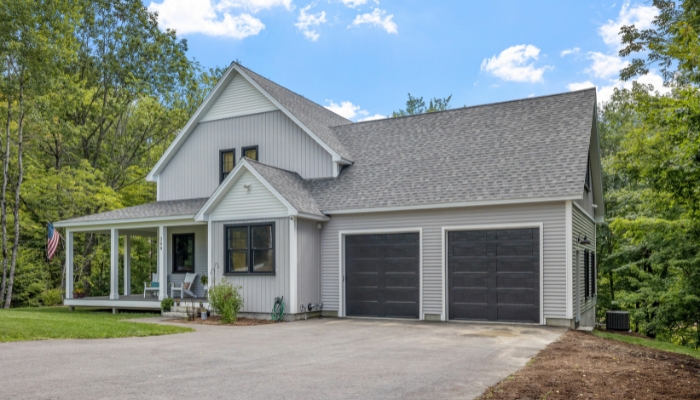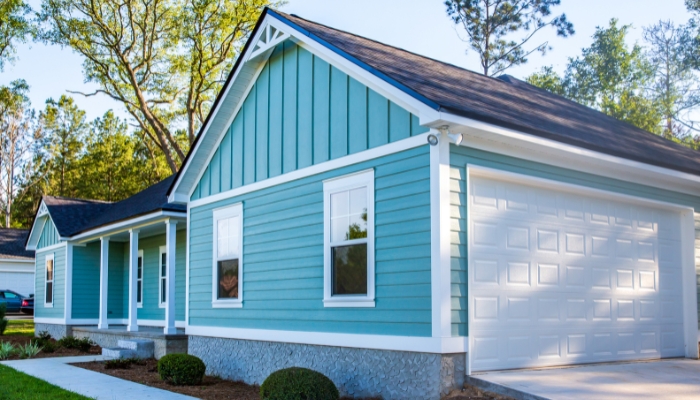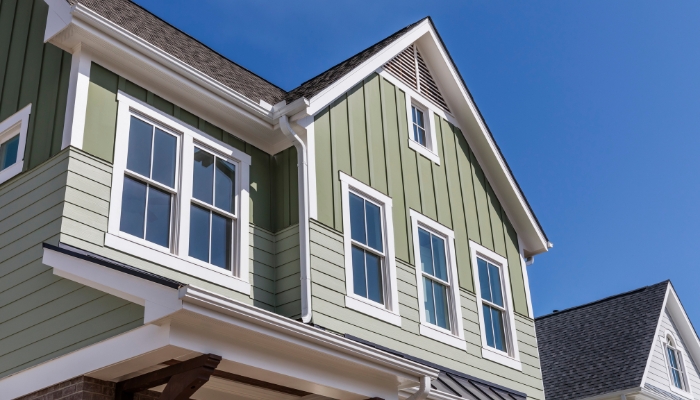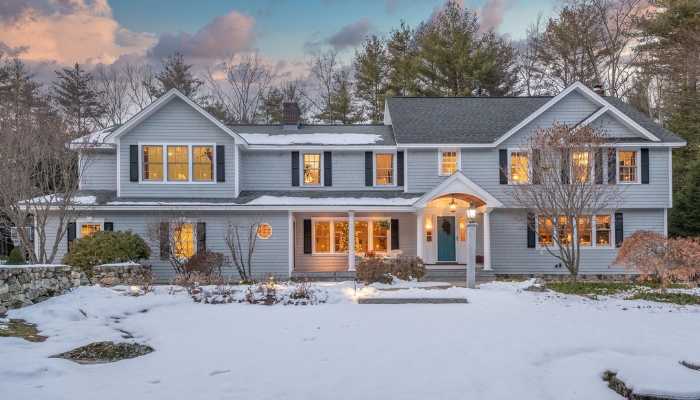Benefits of Composite Siding in Connecticut: Expert Insights
If you’re a Connecticut homeowner concerned about protecting your home from winter weather, this guide to the benefits of composite siding is for you.
Composite siding offers many benefits, including durability in Connecticut’s harsh winter weather. It’s also low maintenance, provides a woodlike aesthetic, and many brands are made with eco-friendly materials.
Keep reading to learn more about the benefits of composite siding and how they can help protect your home.
What is Composite Siding?

As the name might suggest, composite siding is made from multiple materials blended together to form a strong protective layer for your home.
How Does Composition Siding Compare to Other Materials?
Compared to natural wood, composite siding has higher durability and is less vulnerable to pests like termites or weather stresses like moisture. However, some people prefer the look of wood even if it requires more maintenance.
Composite siding is a little more expensive than vinyl siding, which is made entirely out of synthetic materials. Unfortunately, vinyl siding doesn’t hold up as well to the freezing temperatures common in Connecticut winters, so in the long run, the maintenance costs may be higher with vinyl.
Like composite siding, fiber cement like James Hardie planking uses real wood fibers. These are combined with sand and cement to form siding that is highly weather resistant and durable.
What is Composite Siding Made of, and What are the Types of Composite Siding?
It’s helpful to understand that “composite siding” is an umbrella term that embraces several subtypes. This cladding may be made from a wood/plastic blend, a combination of minerals and polymer, or a cellular PVC formula.
The types of composite siding all have their own pros and cons:
WPC (Wood Plastic Composites) or Composite Wood Siding
This composite uses very small wood fibers mixed with plastic binders such as PVC, HDPE, or LDPE. It often contains recycled content and is considered an eco-friendly, durable option.
Additionally, WPC siding is easy to install, so it may be a good option if you want to make the installation a do-it-yourself project.
However, downsides include high initial costs and the possibility of wear or scratches. WPC siding also has poor repairability, so if it suffers damage, you may be looking at replacement costs.
Engineered Wood or Compressed Wood
Engineered wood is made from a process in which lumber wood, often left over from sawmill cuttings, is mixed with additives like adhesives to form compressed wood siding. It’s then treated with formulas that provide fungi and termite resistance.
Options include composite cedar siding and other wood finishes. You can also choose from several installation solutions, including floating, glued, stapled, or click-and-lock systems.
Refinishing can be limited with engineered wood, so if it requires a lot of work, you may need to replace it. Pressure washing and hailstones can also damage the surface coating that provides moisture and termite protection, leaving the siding vulnerable to rot or additional damage.
Cellular Composite PVC

This cladding features PVC with a lightweight, cellular core, making it convenient for shaping and woodworking projects. Compared to typical PVC, it is softer, easier to mold, and more closely resembles real wood.
Cellular PVC is usually shaped into boards with interlocking joints and coated finish for enhanced durability. This allows it to resist moisture and impact damage with minimal expansion and contraction.
However, cellular PVC is more expensive than engineered wood, vinyl, or fiber cement. Additionally, it must be installed before the trim, which may pose installation difficulties for some homeowners.
Mineral-Polymer
Mineral-polymer mixes like Everlast are typically made with over 60 percent stone or mineral content, which is then combined with polymer resins. This process leads to a material with high water resistance, fade resistance, and color retention.
Due to the mineral content, mineral-polymer siding is a challenging material to install, and not the best option for a do-it-yourself project. It may also appear less wood-like than materials that contain wood fibers.
Polymer and Other Composites
Polymer and other composites can be used to produce cladding such as Alside® ASCEND®, which withstands high winds and offers a Class A fire rating. This type of composite allows for easy installation and provides a highly realistic “wood” finish.
Among synthetic wood siding options, polymer composites like Alside also offer a high level of insulation, which is helpful when the Connecticut winter arrives.
While polymer composites have many benefits, they may be somewhat less durable than mineral-polymer or engineered wood siding.
Thinking About a New Roof or Repair?
Get a Free Roofing Quote
K.P. LaMarco Construction offers expert roofing solutions, from repairs to full replacements, using high-quality materials and skilled craftsmanship to protect and enhance your home.
The Core Benefits of Composite Siding
Composite siding has a number of benefits compared to traditional wood siding and other options. Here are some common reasons why Connecticut homeowners choose composite siding:
Moisture and Rot Resistance
Composite siding provides more protection against moisture, and is less likely to rot than natural wood. Mineral-polymer blends offer the most protection as they don’t contain any wood fibers, so there is nothing to rot.
Impact and Wind Performance
When a nor’easter hits, you want to know your home is protected from the harsh gale-force winds, rain, or snow. Many composite siding systems, like engineered wood, have high impact ratings and can withstand intense storms.
Minimal Maintenance and Color Stability

After siding is installed, many homeowners don’t want to worry about frequent repairs or maintenance. With factory finishes you’ll have minimal maintenance and a robust color that lasts for years.
Pest Resistance
No one wants to think about their new siding being damaged by termites or other pests. Composites made of PVC or mineral-polymer combinations don’t attract insects, and engineered wood is typically treated to keep pests out.
Thermal Movement and Seams
Temperature changes can cause siding to expand and contract, leading to stress on the material, and in some cases, cracks or other damage. Composite siding is installed with interlocking designs to reduce gaps and ease the strain on your siding.
Additionally, cellular PVC siding is engineered to restrict visible expansion and contraction.
Curb Appeal and Authentic Wood Lock

While people often buy siding to protect their home, they also want it to look appealing. Some customers tell us they don’t want a plastic or “fake wood siding” aesthetic.
With composite siding, deep embossing and a wide selection of highly realistic wood-tone palettes allows you to choose the best look for your home.
Fire, Weather, and UV Performance
Most types of composite siding provide varying levels of protection against freezing, thawing, and other coastal weather.
Fiber cement and options with acrylic capstock like Everlast are ideal for homes in direct sun, as they hold up well to UV exposure.
Warranty Strength
Each type of composite siding has its own warranty, with brands like Everlast offering limited lifetime warranties. If you have concerns about coverage, your K. P. LaMarco representative can explain what each warranty covers.
Composite vs. Vinyl vs. Fiber Cement vs. Wood
Choosing between composite siding options for your home can be confusing. Here are some areas to consider and compare to your needs:
- Durability and moisture resistance. Composites are much better at resisting moisture than real wood, and won’t become brittle in extreme cold like vinyl can. However, fiber cement may absorb some moisture, so other composites could be a better choice if you have concerns about water damage.
- Maintenance. If you don’t want to spend your spare time cleaning and caring for your siding, that’s understandable. Many composites offer no-paint, low-caulk systems with limited maintenance requirements, and require less upkeep than real wood. Fiber cement will require periodic painting and caulking, so other composites may be a better option if you want low-maintenance siding.
- Appearance. Many composites achieve a more realistic wood finish appearance than vinyl siding. In some cases, fiber cement can also produce a highly authentic-looking wood finish.
- Fire. Wood is the least fire-resistant option for siding. Frequently, composites offer Class A fire ratings, and fiber cement is non-combustible.
- Cost and lifecycle. Costs can vary widely depending on the type of composite you choose, but in general, composites provide better cost effectiveness than options like real wood. Lifecycle costs are also usually lower due to reduced need for painting and maintenance. To determine the best options for your budget, contact K. P. LaMarco for a quote today.
Climate and Weather Performance

It’s hard to avoid concerns about how the harsh Connecticut winters may affect your siding, but you can choose options that hold up well to ice, snow, wind, rain, and other weather events. Here are some ways that composite siding can help you protect your Connecticut home:
- Freezing, thawing, and nor’ easters. Real wood can swell or peel after after freezing and thawing occurs, but composites won’t. Choose a composite with a high wind rating like fiber cement for protection against strong nor’ easter winds.
- UV and color retention. You don’t want the siding color or finish you choose to fade over time. If your home has high sun exposure, consider options like fiber cement or UV-resistant finishes on brands like Everlast.
- Expansion and contraction. As we discussed earlier, Connecticut weather conditions can cause siding to expand and contract, but composites minimize this problem with engineered joints to minimize gaps. Correct installation is key to making the most of an interlocking joint system, so we recommend using an experienced K. P. LaMarco professional installer who is familiar with Connecticut weather.
Maintenance and Care
How can you keep your siding looking its best after it’s installed? Here is a checklist to keep in mind:
Seasonal Checks
These should be performed about twice a year, at the beginning of summer and winter. Walk the exterior of the home and observe the siding. Keep an eye out for loose fasteners, small dings, or gaps. If you see these, contact a professional for repair right away, so they don’t get worse.
Siding should be re-caulked only when necessary, and clearances should be maintained at the flashing and grade. If you’re unsure how to repair damage, always consult a professional.
After Storms or Weather Events
Again, walk around the house and check all windward walls, and around doors and windows, for any sign of cracks or damage. Also examine trim joints and ensure gutters and downspouts are cleared.
Routine Cleaning
A few times a year, it’s a good idea to rinse the siding with a hose. Sometimes accumulated dirt can hide damage that needs to be addressed.
If rinsing fails to remove some spots, you can use a soft brush or cloth with mild soap, followed by another thorough rinse. Avoid abrasive or harsh solvents that may damage siding.
Using a Pressure Washer
If you decide a pressure washer is necessary for cleaning, use low pressure and a wide fan tip to avoid strain on the siding. Keep the wand moving and never spray up into laps or seams.
What to Avoid
Don’t use narrow, high-pressure nozzles. If you decide to repaint, avoid paints or coatings that are not approved for your type of siding.
Call the Pros
If you notice swelling, persistent stains, loose panels, or frequent moisture around joints, always contact a professional for advice. Guessing or taking a do-it-yourself approach could prove more costly in the long run than getting professional help at the outset of difficulties.
Need a siding health check tailored to Connecticut weather? Contact K.P. LaMarco Construction for a fast, free quote
Thinking About a New Roof or Repair?
Get a Free Roofing Quote
K.P. LaMarco Construction offers expert roofing solutions, from repairs to full replacements, using high-quality materials and skilled craftsmanship to protect and enhance your home.
FAQs
• Looks like real wood with far less upkeep.
• Resists rot, termites, and moisture; good for freeze–thaw climates.
• Strong impact and wind performance.
• Wide range of profiles and factory colors; finish holds well.
• Long warranties (often 30–50 years) and stable dimensional performance.
• Higher upfront cost than vinyl.
• Must be installed with correct flashing and clearances; poor install can lead to swelling or delamination.
• Dark colors may fade; some products need repainting every 8–15 years.
• Heavier material; cutting/handling usually calls for pro tools and safety gear.
• Spot repairs can be noticeable if the color has aged.
• Typically 30–50 years with proper installation and maintenance.
• Engineered-wood lines often last 25–40+ years; fiber-cement or polymer-mineral blends can reach 50+.
• Keep caulk and paint in good shape, clean gutters, and maintain ground clearance to maximize life.
• Pros: durable, rot/bug resistant, low routine care, strong weather performance, realistic wood look, long warranties, better fire performance than vinyl (varies by product).
• Cons: higher initial cost, needs careful moisture management during install, potential repainting/fade over time, heavier and harder to DIY, repairs can be visible.
Conclusion
Composite siding offers many benefits, including lower labor costs and maintenance expenses than traditional wood siding. Depending on the type of composite you choose, you may have lower upfront costs or higher resistance to Connecticut winter weather. Advantages of composite siding may also include higher ratings for fire, impact, or wind resistance.
The most important consideration is to choose siding appropriate for your home’s location and the local weather here in Connecticut. To learn more about your options and the best solutions for your home, contact K. P. LaMarco for a free quote.








